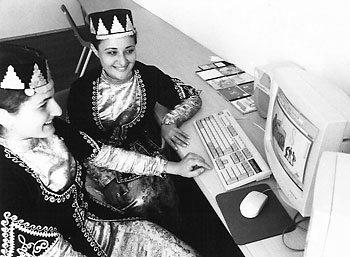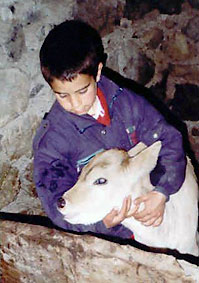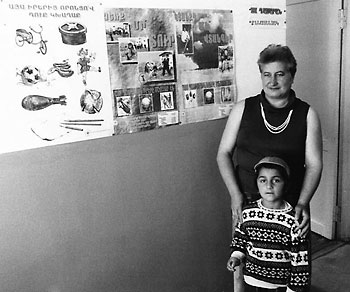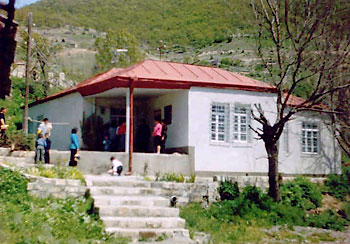
Monte Melkonian Fund
DEVELOPMENT OF THE KAREGAH PROJECT
A REPORT BY ALEC YENIKOMSHIAN
 |
Computer room, Smbat Tatosian Center for Adolescents and Youth, Karegah village. |
Since summer 2002, a wide-ranging development program is being carried out in Karegah, a village in the liberated Kashatagh region of Artsakh (Mountainous Karabagh). The MMF wishes to share its results, describe the current state of affairs, and reflect on the issue of development projects with its friends.
The program covers different aspects of the community life: livestock breeding and agriculture; employment; education; cultural life and particularly the establishment and operation of an adolescents/youth center; self-organization of the community, etc. This program is the result of the combined efforts of generous benefactors, particularly Mr. Edik Abrahamian, the Monte Melkonian Fund (MMF), and the village community itself.
Karegah is situated some four kilometers north of the town of Berdzor (formerly Lachin), the administrative center of Kashatagh. It is located in an area with good pastures but poor agricultural lands. With its more than 250 inhabitants, Karegah is one of the biggest rural communities of Kashatagh. Its current population started to settle there in 1994. The population is made up of refugees who have been forced to desert their villages in Shahoumian, Getashen and other regions still occupied by Azerbaijan, as well as by settlers from the Republic of Armenia. Prior to the implementation of the program, almost half the families did not own even a single cow and had to buy milk in order to feed their children. Furthermore, because of the lack of financial means, the villagers had been unable to exploit the village's fifty hectares of adjoining land. Due mainly to a shortage of water in the village, many of the families still cultivate only a tiny portion of the plots situated close to each house. It is not surprising therefore that 90% of the people of working age have to work for meager salaries in Berdzor, where the villagers go and come back from mostly on foot.
As for the village school, it could be qualified as excellent in many respects, compared to schools of other villages in the region. The building is in very good condition, and the administrators as well as most of the teaching staff are competent individuals. However, as in the case of the other schools of the region, there is a shortage of qualified teachers for some of the subjects taught, as well as a big shortage of textbooks due to the exclusion of the liberated areas from the textbook publication and distribution program sponsored by the World Bank in the Republic of Armenia. These two factors have no doubt stood in the way of improving the quality of education received by the children. Needless to say, the school did not have a single computer. There was no organized cultural activity in the village, nor any program to enhance the skills of the youth, who also lacked a gathering place for entertainment.
* * *
The idea of implementing a development program in Karegah gradually took shape following an initial phase of contacts and mutual acquaintance between the leaders and members of the community and the Monte Melkonian Fund. The two sides agreed on a set of projects covering different aspects of the community life. The implementation of the projects agreed upon became possible thanks to many donations, but mainly to a very generous donation by our compatriot Edik Abrahamian, in memory to his late father, Arshak Abrahamian.
* * *
II. The Projects
Two types of projects have been implemented in the village during the last two years: those aiming at improving the economic and social conditions of the villagers and the community as a whole, an those aiming at the improvement of the cultural and spiritual life of the village.
Since the economic projects are income-generating by nature, they are implemented in the form of loans. The loans are extended on very favorable terms, but not as unidirectional aid. This approach is also dictated by the urgency of getting rid of the debilitating mentality of relying endlessly on material help from others, an attitude still dominant among a certain section of Armenia's population.
The projects of a cultural and spiritual nature, on the other hand, are naturally carried out without any expectation of monetary or material reimbursement. In order to secure their on-going financial expenses, however, the program attempts to implement other income-generating projects in and outside the village.
The following projects have been implemented in Karegah since the summer of 2002. Almost all of them have been organized on the ground and led by the village mayor, Mrs. Marine Bedoyan, whose role has been pivotal.
1. Livestock Breeding
 |
A young Karegah resident with his calf, courtesy of the Cow Pass-On Project. |
26 needy families have been provided with one cow and one calf each for a period of two years, on a "pass on" basis. This method allows the family to fully benefit from the cow's milk and dairy products during those two years, and also to raise the calf to keep. Thus, each of these families will own a full-grown cow or bull at the end of the two years period. In addition to the calf, each cow will more than likely give birth to two more calves during the two years of this project. The family must raise the first-born calf until it is mature enough to be returned to the program, in order either to be eventually given in turn to another needy family, or to be sold to sustain the on-going projects in the village. When the two year period is over, the same cow and the third calf will serve for another similar transaction, either with the same family-if both parties agree--or with a new one.
The project has proven to be very successful and popular in the village. Besides providing each participating family with its own calf, it has relieved them from the anguish of having to continually look for ways to secure milk and cheese for their children. And it has done so while preserving their dignity and providing them with a sense of pride to the effect that they will eventually reimburse their loan (the cow and the third, last-born calf), together with interests (the second calf), and thus allow another family to benefit from the same opportunity they themselves have enjoyed.
Another characteristic of the project was that, in order to overcome common problems together and to be of mutual assistance to each other during these two years, the participants formed their own small cooperative-kind union.
2. Agriculture
Karegah village possesses not more than 50 hectares of non-irrigated and low-grade arable lands. For two consecutive years the 50 hectares of non-irrigated lands belonging to the village were cultivated and planted with wheat. The villagers had the desire to cultivate the 50 hectares-the only potentially arable lands the village possessed--prior to their cooperation with MMA, but had been unable to do so because of the lack of financial means. The realization of this objective became the first large-scale project on which the village and the association agreed upon in the summer of 2002. It was decided then that MMA would provide the financial means for the cultivation and that the community would pay back the same amount after the selling of the harvest. The agreement amounted therefore to a non-interest loan. In addition, the community was provided with two tractors to perform the required agricultural work. It was hoped that the harvest would be enough to reimburse the loan (i.e. to cover the incurred expenses of the first year's cultivation), and in addition to secure enough cash to cover the expenses of the next cultivation. Each family would thus have been provided with means to cultivate its own small plot of land, because the field in question would eventually have been divided among the villagers.
Unfortunately, the wheat project proved to be materially unrewarding. Both in 2003 and 2004, the harvest was poor, in spite of the fact that all the requirements of the cultivation process had been fulfilled. In addition to the unfavorable climatic conditions prevailing in the region during these two years, the basic reason of the unsatisfying results has most probably been the poor quality of the soil. After this year's repeated poor harvest, completed in late July-early August, it was decided to abandon the cultivation project and make use of the available 50 hectares to further enhance livestock breeding in the village. The income expected from the selling of this year's wheat harvest should be invested in this direction. The exact nature and the details of the replacement project are still a matter of discussion among the villagers and MMF, and should be decided soon.
But despite the failure of the wheat cultivation project as such, the human efforts invested towards its realization has given a major boost to the cohesiveness of the village and to its internal organization, not to mention the part-time employment and income the project provided to dozens of villagers. If the project had been successful, each family involved would eventually have ended up with its own plot of land; nevertheless, during the two years of the project the work was done on a collective basis: Dozens of men--and depending on the type of work, of women and even children, too--participated together in the different tasks, such as clearing the field from pieces of rocks and stones, the filling of the seeds in hundreds of bags, the implementation of measures against rodents, the guarding of the field day and night in the weeks preceding the harvest, and all the other tasks required during the different phases of plowing, planting, fertilizing, harvesting, and so on. Some of these efforts were paid for and some performed on a voluntary community-work basis. As a result, the community organized itself well and prepared itself to rapidly execute tasks deemed important for the village. The mentality of working collectively for the good of the whole community began to take root. The villagers, who have come to Karegah from different areas of Armenia, socialized much more with each other, and the bonds and camaraderie strengthened among them. The village took important steps towards the shaping of its own identity
3. Textbooks for the School
 |
A student and a teacheer in Karegah's elementary and secondary school, K-11. In the hallway appear posters describing the various sorts of landmines that children might encounter in the surrounding fields. Landmines continue to pose a terrible danger to the inhabitants of Artsakh, especially children. |
The village school and the students were provided with much needed textbooks. The textbooks used in the Republic of Armenia are published and distributed to the schools by the ministry of education with the help of a World Bank loan. As mentioned above, the schools operating in the liberated areas are excluded from this distribution program and therefore encounter a big deficit of textbooks, which they are unable to fill because of obvious financial problems. The ongoing program in Karegah almost resolved the matter for this village by acquiring a large quantity of textbooks and each student now shares his textbooks at most with one other classmate, instead of three or four classmates, as they used to do before.
4. Adolescents/Youth Center
Perhaps the most remarkable accomplishment of the Karegah development program has been the establishment and the running of a unique youth center called the "Smbat Tatosian Center for Adolescents and Youth of Karegah." The mission of the Center, on the one hand, is to cultivate through art lessons the aesthetic taste of the village children and youth, and to satisfy their cultural needs. The other part of the mission is to bring about the emergence of a cultured, decent, patriotic young generation, a generation well aware of its civic duties and rights, and respectful of the environment. Another objective of the Center is to fill some of the educational gaps that, for comprehensible reasons, remain unmet by the school.
In this context, the Center has established computer classes, arts groups (including theater, dance, photography, and soon ceramics), and sports groups (including soccer and karate). English language and psychology courses have also been taught for periods of several months. Other disciplines should be added to the list with time.
The young people of the village participate in these activities at will and free of charge. In addition, lecture/game sessions are organized at the Center on patriotic, civic, ethical, spiritual, and contemporary issues; festivities are held on religious and national significant feast-days; excursions are organized on holidays, etc. Another important component of the Center's activity is the carrying out of community and environmental work by the young people of the village.
The director of the Center is the mayor of the village, who is a university graduate and a teacher experienced in working with children. The teachers for the different groups come either from the village or from Berdzor. A car put at the disposal of the village to serve the different projects is permanently used for the needs of the Center.
The Smbat Tatosian Center, which has been functioning since July 2003, has proven to be a major success and has already brought a new quality into the lives of the children and adolescents of the village. The theatre group won the first place in the Karabagh Youth Theatre Festival organized in late May in Stepanakert and participated successfully in the Pan-Armenian Children's Theatre Festival organized in August in Yerevan. The dance group also participated in the "One Nation, One Culture" festival held in August in Yerevan, performing with the Berdzor dance group. The photography group exhibited its pictures of Karegah in Yerevan and Stepanakert in March and April, attracting the attention of the public and of the mass-media.
 |
The Smbat Tatosian Adolescent and Youth Center of Karegah. |
The Youth Center of Karegah is named after Smbat Tatosian, the former mayor of the village and a veteran of the Artsakh war. A devoted and modest personality, he died in a truck accident in 1998, while on duty as village head.
5. Income Generating Initiatives to Sustain the Non-Economic Projects
As I have mentioned, economic projects such as the cultivation of the wheat fields and the cows' "pass on" project have been financed in the form of loans, whereas the non-economic projects have naturally been financed without any expectation of reimbursement. In addition, some of the projects, particularly the continuous functioning of the Smbat Tatosian Adolescents/Youth Center entail on-going expenses. (These expenses include teachers' and personnel's salaries, taxes, and activities and maintenance expenses, such as gasoline and car maintenance expenses for trips at least twice a day on rugged roads back and forth from Berdzor, in order to transport teachers to and from the school).
In order to cover these recurrent expenses on a continuous basis without having to rely endlessly on external donations, the Karegah development program has sought to establish income generating projects. A cattle breeding farm has been established in the village, a farm that at present counts 25 bulls. The program also participates in other cattle breeding and bee breeding business projects in the region, outside the village. However, the program is in need of additional funds to be invested in these same income-generating projects, or in new ones, in order to secure a sufficient flow of income to cover all the recurrent expenses of the youth center and the other projects.
6. Job Creation and Wage-Income Generation
The implementation of the above mentioned projects, and more precisely the construction and operation of the youth center and of the cattle farm, as well as the cultivation of the wheat field, have created many jobs of a full-time, part-time or temporary nature. These jobs have provided many villagers and other residents of the region with much needed wage income.
* * *
The total sum of the expenses of the above mentioned projects since their beginning until August 2004 has amounted to around 60,000 US dollars. Of this sum, $21,000 was spent on the youth center. Of this total sum for the youth center, $7,470 was spent on the construction of the building; $4,890 was spent on acquisition of equipment and furniture; $1,710 was spent on the acquisition of the car; $6,800 was spent on more than a year of activities; and the remaining $130 was spent on documented miscellaneous expenses.
Another $13,450 was invested on income generating projects. Of this sum, $2,995 was spent for the construction of the farms in the village; $2,620 was spent for the acquisition and breeding of the bulls in the village; and $7,830 was spent for the animal and bee breeding projects outside the village.
More than $11,500 was spent the first year for the fields' cultivation. Most of that sum returned through the sale of the wheat harvest and was reinvested, with some additional amount, for the second year's cultivation.
An additional $4,750 was spent for the tractors and their parts; $6,700 was spent for the cows' "pass-on" project, and $1,150 was spent on the school.
Aside from the material and spiritual rewards these investments have brought to the community and its members, most of this amount still exists in the form of livestock, harvest, buildings, equipments, etc.
* * *
The above description of the development projects in Karegah gives a fair idea of the accomplished and expected results. Despite the disappointment caused by the cultivation project, the overall program has yielded real and tangible economic returns. Nevertheless, the starting point was so low that the projects are still far from satisfying all the basic needs of the villagers, many of whom continue to remain very poor. The replacement of agriculture by further animal breeding, as well as other projects should noticeably improve the economic situation. The most important achievements, however, have been the transformation that has taken place in the lives of the children and the drastic change in the psychological make-up of the villagers, who are much more organized and self-confident. Today the people of Karegah look to the future with great hope.
* * *
III. Some Comments on the Approach Adopted by the Karegah Program
The description of the Karegah projects portrays the pattern according to which the Monte Melkonian Fund considers the issue of the development of the liberated areas, and with some adjustments, of the other underdeveloped rural regions of Artsakh and Armenia. Without going into too much detail, the main characteristics of that pattern are the following:
1. Comprehensiveness
A village, like any other community, is a multi-faceted entity, consisting
of people having economic, social, cultural, spiritual and other needs and relations.
A qualitative change in the life of the village as well as a real improvement
in the quality of life of the villagers is achieved when all or most of these
aspects are dealt with in a harmonized manner.
The approach in Karegah has therefore attempted to address the communities' problems
in a comprehensive manner, as opposed to singling out and focusing on individual
problems.
2. Providing Equal Chances to All
Social justice and the averting of polarization are among the basic requirements
of every harmonious and healthy society. Moreover, the areas liberated during
the Artsakh war represent, together with many other areas of Armenia, an enormous
strategic significance from the point of view of the national security of the
country. These areas, should, therefore, be settled by healthy communities, exempt
from internal strife and polarization.
The adopted principle in the implemented programs is therefore to assist in the
harmonious development of the communities by providing equal development opportunities
to all, averting the emergence of big social differences among the villagers and
the domination of the majority by a few.
3. Trying to Ensure a Healthy Balance between Individual and Collective Interests and Ways of Thinking
As a result of the unexpected and at times dazzling changes that succeeded one another since the early 1990s, a large number of Armenia's population found itself in a confused and disarrayed state of mind. The collapse of the old system of values and the acute social conditions forced many people to consider matters from a very narrow, highly individualistic and at times even anti-social point of view.
The manner in which the Karegah projects are conceived and implemented is intended to induce people to stop seeing contradictions between individual and collective interests, and on the contrary, to realize that the pursuit of collective interests is also beneficial for individual interests.
4. Reliance on Local Resources
The areas liberated during the Artsakh war represent a big economic potential,
because they are rich in agricultural and animal breeding resources. Besides their
direct use by the inhabitants of the region, these resources can and should be
used for income generating purposes in order to finance the development of the
communities of these same areas.
It is with this understanding, for example, that instead of endlessly relying
on external help for the continuous operation of the youth center of Karegah,
the MMF has invested some of that help in animal breeding projects which should
themselves finance the Center. Further external help can in this way be used for
the realization of other projects.
* * *
The Monte Melkonian Fund is ready to cooperate with other interested parties to implement development programs in the liberated areas or elsewhere in Armenia within the general framework mentioned here.
Alec Yenikomshian
The Monte Melkonian Association, director
Yerevan
September 7th, 2004
MMF, Inc. Copyright © 2002-2007